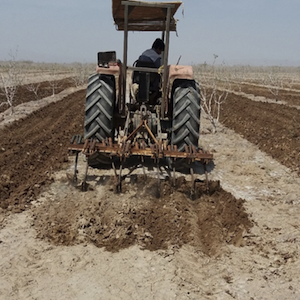A decade-long study on the effect of furrow and subsurface drip irrigation using unconventional water on soil salinity and the growth of pistachio trees

APPENDIX: 83
HTML: 22
All claims expressed in this article are solely those of the authors and do not necessarily represent those of their affiliated organizations, or those of the publisher, the editors and the reviewers. Any product that may be evaluated in this article or claim that may be made by its manufacturer is not guaranteed or endorsed by the publisher.
Furrow irrigation is the most common method of irrigating pistachio orchards in Iran. Water use efficiency using this method of irrigation is close to 35%. Ten years ago, a subsurface drip irrigation (SDI) project was initiated with highly saline and alkaline water for the first time in Iran at the Feyzabad pistachio research station, at 34̊ 54ʹ 15ʺ N, 58̊ 45ʹ 37ʺ E, located in the northeast of Iran, at an altitude of 850 meters from the sea. The water salinity and sodium adsorption ratio were 11.5 dS m-1 and 15.5 at the beginning of the project, and they reached 16.25 dS m-1 and 17.7 in 2021. The amount of SDI water consumption in the first year of the project (2012) was 1640 m3 ha-1 yr-1, and as the trees aged, water consumption reached 3000 m3 ha-1 in 2022. The amount of water utilized for furrow irrigation was about 6912 m3 ha-1 in 2022. Salt entering the soil through irrigation water differed by about 41 t ha-1 in 2022 between the two methods. After ten years of project implementation, the root development layer was more than 100 cm and less than 50 cm, respectively, for SDI and furrow. The trend of soil salinity has changed from 2012 to 2022: it went from 34.7 dS m-1 in 2012 to 110 dS m-1 in 2018, and then decreased to 65 dS m-1 in 2022 in the surface layer of the SDI method. In contrast, salinity increased almost twofold within the root development layer (60-140 cm) in the SDI. In the last two years (2021 and 2022), the height, crown width, trunk circumference, and yield of the pistachio trees were not significantly different between the two irrigation methods. However, there was a significant difference in the irrigation treatments during the two last years (2021 and 2022) in the annual growth, the average number of flower buds in the branch, and the average number of flower buds abscised. The branch vegetative growth in 2022 had decreased by almost 50% compared to 2021 in both methods. The results showed that the lowest annual growth was achieved in the SDI in 2022. Overall, the efficiency of water consumption in the SDI and furrow was equal to 0.09 and 0.06 kg m3, respectively. SDI net income was 1284 $ higher after expenses were deducted from 2012 to 2022. Therefore, due to severe climate change and excessive salinity increase in soil and water resources, a well-managed SDI can provide a more sustainable production method for salt-affected soils for pistachio orchards by reducing water consumption and salt entry into the soil.
How to Cite

This work is licensed under a Creative Commons Attribution-NonCommercial 4.0 International License.
PAGEPress has chosen to apply the Creative Commons Attribution NonCommercial 4.0 International License (CC BY-NC 4.0) to all manuscripts to be published.

 https://doi.org/10.4081/ija.2023.2196
https://doi.org/10.4081/ija.2023.2196







